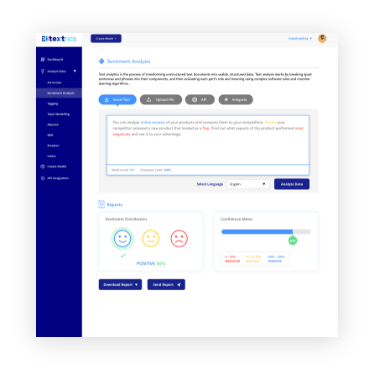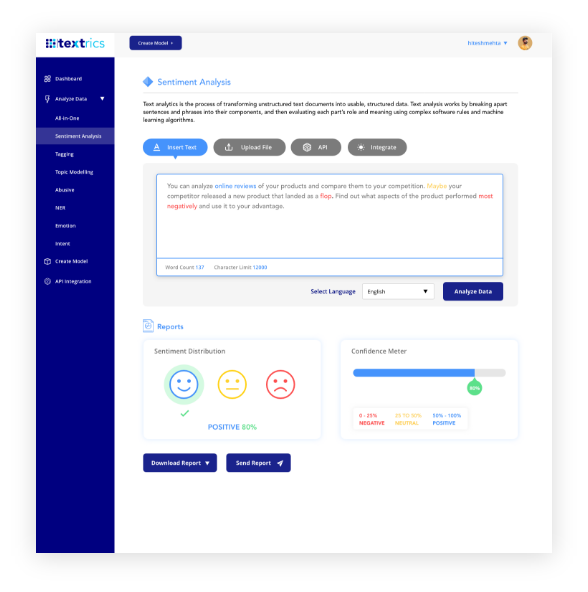

Precise
Potent
Powerful
Text Analysis in a click
Text analysis of large amounts of unstructured data can be daunting. Find solutions to all your text-related challenges with Textrics in just one click.


 Sentiment Analysis
Sentiment Analysis
Sentiment analysis means contextual data mining wherein you input a sentence and it is categorised according to the underlying consumer emotions of positive, negative or neutral. Through an intensive training and analysis of as many as 1 million sentences, ...we have mastered the art of identifying the underlying human sentiments in your text.
 Topic
Modelling
Topic
Modelling
Topic Modelling involves a statistical model that extracts abstract “topics” from your text based on the frequency of the particular terms used. However, this organizing and extracting information from large chunks of unstructured text can be pretty ...time-consuming. We optimise this process for you through our avant garde technology.
 Abusive Language Detection
Abusive Language Detection
This is a critical function in text analysis of identifying abusive or offensive text across social media platforms extracted from any contextual data source. With the rise in digital consumption, it has become important to monitor offensive content and ...take corrective actions by ORM or damage control. (retaining ORM or damage control as per our discussion) Our algorithm detects abusive text and the frequency of its usage to enable companies keep their content clean and professional.
 Tagging
Tagging
It is the process of preparing text for analysis by adding tags or annotations to different components of unstructured data. Reading long sentences and noting keywords manually can be tedious. To simplify this task for you, Textrics uses NLP techniques... to identify the top 3 words or terms that bear more weightage or value in a sentence, through tagging.




 Intent Analysis
Intent Analysis
This is a process of determining the underlying intention behind a text. Understanding this can help us classify the data quicker. Our software promptly classifies data into news, opinions, marketing and spam to understand the ‘intent’ behind the text, ...using RNN deep-learning techniques.
 Emotion
Detection
Emotion
Detection
It is the accurate identification of emotion from contextual data. When you need to gain a deeper insight into the underlying tone of a text, emotion analysis comes into play. The Textrics suite is trained to classify your text into emotions like happy, sad, angry ...and fearful, based on RNN deep-learning technology.
 Name Entity Recognition
Name Entity Recognition
Extraction of named entities from unstructured contextual data such as names, locations, brands, etc. is helpful when it comes to analysis. With the help of our efficient Name Entity Recognition, extracting these entities from articles is ...faster.